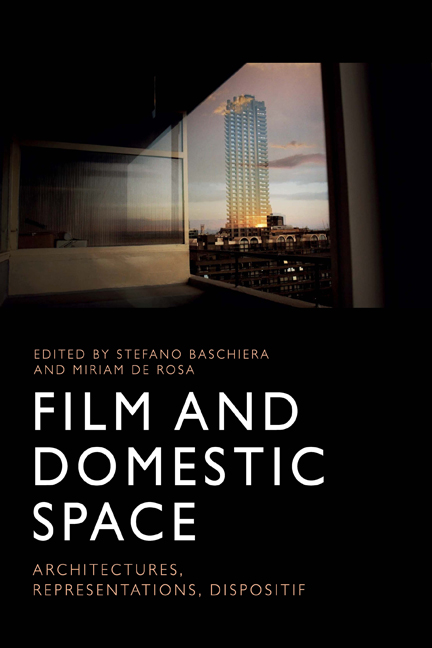Book contents
- Frontmatter
- Contents
- List of Figures
- Notes on the Contributors
- Acknowledgements
- Introduction
- 1 Architectures of Ubiquity: The Colonial Revival in Film and Television
- 2 No Down Payment: Whiteness, Japanese American Masculinity and Architectural Space in the Cinematic Suburbs
- 3 Resist, Redefine, Appropriate: Negotiating the Domestic Space in Contemporary Female Biopics
- 4 Liminal Spaces, Lesbian Desire and Veering off Course in Todd Haynes’s Carol
- 5 A Home on the Road in Claire Denis’s Vendredi soir
- 6 Acoustic Ectoplasm and the Loss of Home
- 7 Our House Now: Flat and Reversible Home Spaces in Post-war Film and Television
- 8 From Myth to Reality: Images of Domestic Space in Post-Soviet Baltic Films
- 9 No | Home | Movie: Essay Film, Architecture as Framing and the Non-house
- 10 At Home with the Nouvelle Vague: Apartment Plots and Domestic Urbanism in Godard’s Une femme est une femme and Varda’s Cléo de 5 à 7
- 11 Dwelling the Open: Amos Gitai and the Home of Cinema
- 12 What Is Cult When It’s At Home? Reframing Cult Cinema in Relation to Domestic Space
- 13 High-fructose Cinema and the Movie Industrial Complex: Radicalising the Technology of Representation in a Domestic Kind of Way
- Index
12 - What Is Cult When It’s At Home? Reframing Cult Cinema in Relation to Domestic Space
Published online by Cambridge University Press: 22 September 2020
- Frontmatter
- Contents
- List of Figures
- Notes on the Contributors
- Acknowledgements
- Introduction
- 1 Architectures of Ubiquity: The Colonial Revival in Film and Television
- 2 No Down Payment: Whiteness, Japanese American Masculinity and Architectural Space in the Cinematic Suburbs
- 3 Resist, Redefine, Appropriate: Negotiating the Domestic Space in Contemporary Female Biopics
- 4 Liminal Spaces, Lesbian Desire and Veering off Course in Todd Haynes’s Carol
- 5 A Home on the Road in Claire Denis’s Vendredi soir
- 6 Acoustic Ectoplasm and the Loss of Home
- 7 Our House Now: Flat and Reversible Home Spaces in Post-war Film and Television
- 8 From Myth to Reality: Images of Domestic Space in Post-Soviet Baltic Films
- 9 No | Home | Movie: Essay Film, Architecture as Framing and the Non-house
- 10 At Home with the Nouvelle Vague: Apartment Plots and Domestic Urbanism in Godard’s Une femme est une femme and Varda’s Cléo de 5 à 7
- 11 Dwelling the Open: Amos Gitai and the Home of Cinema
- 12 What Is Cult When It’s At Home? Reframing Cult Cinema in Relation to Domestic Space
- 13 High-fructose Cinema and the Movie Industrial Complex: Radicalising the Technology of Representation in a Domestic Kind of Way
- Index
Summary
To see a great film only on television isn't to have really seen that film. It's not only a question of the dimensions of the image: the disparity between a larger-than-you image in the theater and the little image on the box at home. The conditions of paying attention in a domestic space are radically disrespectful of film. Now that a film no longer has a standard size, home screens can be as big as living room or bedroom walls. But you are still in a living room or a bedroom. To be kidnapped, you have to be in a movie theater, seated in the dark among anonymous strangers. (Sontag 1996: 60)
In her celebrated elegy to the bygone days of a dying form of cinephilia, Susan Sontag bemoans the shift from cinema being primarily experienced in a darkened movie theatre to an era in which films are being viewed at home in a living room or bedroom. While the rise of the ‘new cinephilia’ (Shambu 2014) has challenged this notion of cine-love being intimately tied to the communal space of the movie theatre, the terms of Sontag's critique nevertheless continue to resonate with much of the discourse surrounding cult cinema. From I. Q. Hunter's assertion that ‘to some extent … cult is a historical category’ (Hunter 2016: xiii) to Jonathan Rosenbaum's claim that in the contemporary era ‘cult films no longer exist’ (Rosenbaum 2008), there is a recurrent emphasis upon a particular understanding of cult that is tied to the historical phenomenon of the midnight movie and the associated film theatres such as The Elgin in New York and The Scala in London. Even where there is acknowledgement that the concept of cult has undergone a semantic shift since its heyday in the 1970s and 1980s, there is nevertheless a continued nostalgic harking back to that earlier era in which cult films were primarily experienced in the communal environment of the movie theatre surrounded by a fellow group of cultists.
Given that we are nearing fifty years since El Topo (Alejandro Jodorowsky, 1970) first played as a midnight screening at The Elgin, it is evident that this limited conception of cult has been challenged by social and technological changes in the intervening years – not least of which was the introduction of cult films into the home through video, DVD and internet streaming.
- Type
- Chapter
- Information
- Film and Domestic SpaceArchitectures, Representations, Dispositif, pp. 210 - 225Publisher: Edinburgh University PressPrint publication year: 2020

